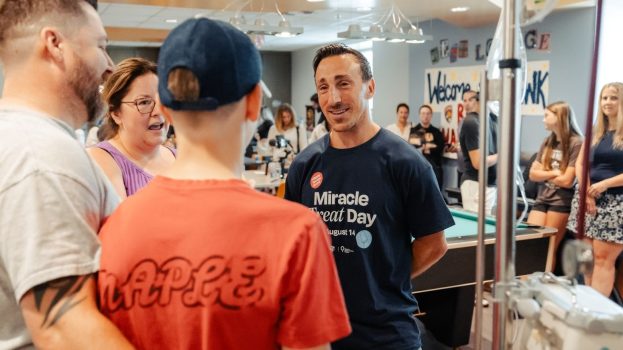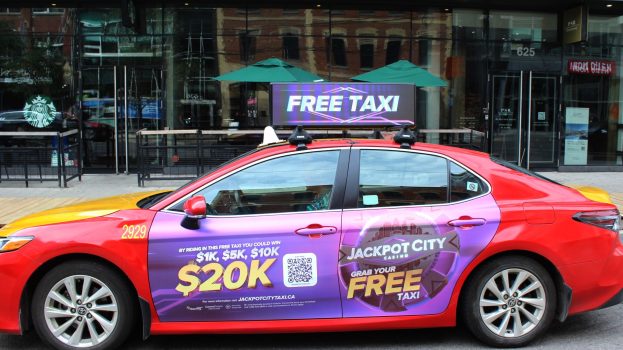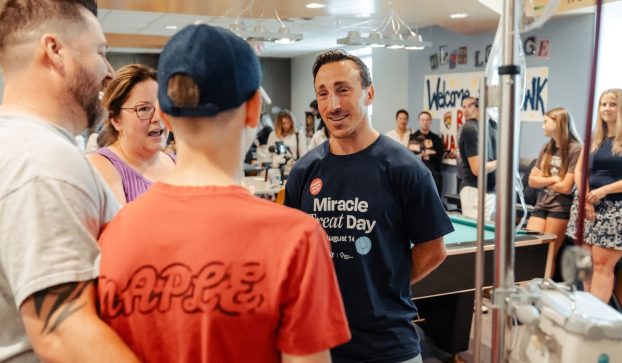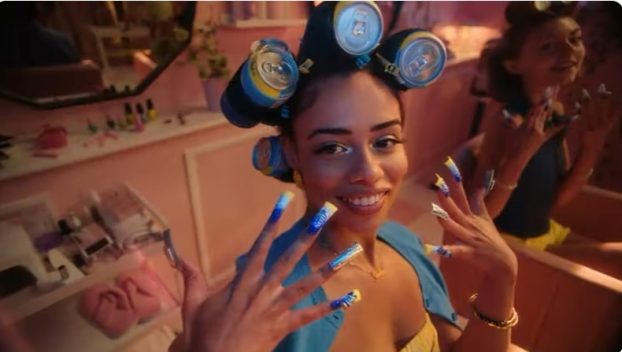Pictured above: The CFL’s Christina Litz, Mindshare’s Devon MacDonald, SickKids’ Lori Davison and Andrew Saunders from the Globe and Mail at the strategy/Media in Canada roundtable.
This article appears in the October 2017 issue of strategy.
By Val Maloney and Bree Rody-Mantha
Consumers are more complicated than ever. There never seems to be enough talent, or at least the right kind. And, oh yeah, consultancies are staking a claim to traditional agency territory.
There is no shortage of issues when media agency leads and brand execs congregate to talk about change and competition. The latest strategy/Media in Canada roundtable was no exception.
strategy: What tool or process has your agency been flexing hard in 2017?
Joseph Leon: One area that’s becoming a much greater focus for us is the infrastructure around technology. So, things like cloud computing and machine-learning. All of those more complex, behind-the-scenes pieces that involve a very significant capital investment, a very different set of skills — that’s where we’re seeing a lot of our focus in 2017 shift.
It’s interesting because if you think about all the people at this table, whether you’re an agency or you’re a business, that’s not necessarily something that’s a fundamental part of our team skillset. As we’re enabling that change and figuring out the opportunity from a media perspective, it’s also providing a bit of impetus to look at the skillset to maximize potential. If I was going to say one thing, 2017 is a focus on infrastructure, the backside of technology and the data.
 Robert Jenkyn: We’re really investing in people and culture as well as that back-end infrastructure. For a couple reasons: One, everything is digital all the time. I get that, but it’s evolving so fast that change is the new normal. What we’re finding now is that, to keep sticky with our clients, we really have to solve that problem of “What part of my advertising is working?” That seemed to be the big driver over the last couple of years.
Robert Jenkyn: We’re really investing in people and culture as well as that back-end infrastructure. For a couple reasons: One, everything is digital all the time. I get that, but it’s evolving so fast that change is the new normal. What we’re finding now is that, to keep sticky with our clients, we really have to solve that problem of “What part of my advertising is working?” That seemed to be the big driver over the last couple of years.
Cathy Collier: Most of the technology has been about how it’s influenced the business and not about how it’s impacted consumers lives or our own lives. But I find technology is distracting us from what we should be focusing on, which is clients’ objectives. And I think the shift this year is spending less time with which “bits” fit into which ideas.
Everyone probably saw that the Media Grand Prix [in Cannes, Jet.com’s “Innovating Saving” campaign] this year was really fueled by an idea. And you didn’t see the bits that came together. You just saw the end-product and how that all resonated from the brand.
I think that’s the biggest thing for me: that we stopped talking about the bits and started talking about the idea and how it’s driving the client’s business.
Lori Davison: And the agency that won that Media Grand Prix was a creative agency…
Collier: I know, so disappointing.
Davison: That speaks to the convergence and overlap that’s going on now. It’s so grey now as to where the ideas come from. Not to get cliché, but the media is the message. The origin of the media is in the idea.
Collier: And it has to be so intermixed. We have to be able to work out the complexity of executing in 20 different channels in different ways. You can’t just have a blocking chart that says you need a TV ad.
Christina Litz: For the most part, the marketing people we have on the team are digital-first and they came to us from various organizations where they were developing products. We have brought a lot of our products in-house, from videogames to apps to geeky things like stats systems that allow us to power new interactions, and we have seen that pay off in a relatively short period of time. And we have to. We don’t have the budgets and reach that some of the international leagues and teams do so we have to think differently, be nimble and try and fail, and fail fast [when we do].
Our investment has been in the type of people we are bringing into the organization who are used to working fast and can be agile and try things. We are inspired and we’re learning a lot by the way our fans are interacting with each other online.
What are media agencies’ biggest challenges and competitors today?
Collier: To be completely honest, the biggest competitors we have now aren’t the people at this table – it’s the consultants.
I think we are really well-poised to go head-to-head, as we’ve been evolving in terms of strategy and thinking and data.
Jenkyn: And they’re moving into our space from the C-suite, so they have a different advantage than we do. And some are coaching their clients to bring everything in-house, which in some instances might be a good idea and for others might not be scalable or feasible for a long time.
So, then, how are you proving your worth as agencies and showing clients that there are some things that shouldn’t be brought in-house?
 Collier: I think it depends on the clients. Every client has a different point on the scale of how much they want in-house, how much they can handle in-house. What we do changes so fast and the scale of what you have to have in terms of the resources – you really have to staff against it.
Collier: I think it depends on the clients. Every client has a different point on the scale of how much they want in-house, how much they can handle in-house. What we do changes so fast and the scale of what you have to have in terms of the resources – you really have to staff against it.
And in terms of competing with consultants, yes, a lot of them are coming from the C-suite but when we’re comparing model to model, I think we’re really well-stacked against them to have the right conversations.
Jenkyn: I think that piece about scale and staying current is very challenging for a lot of clients, especially larger clients bringing large-scale media shops within their business. They don’t necessarily recognize the expense of the people involved, and I don’t think they often recognize the pace of change.
Devon MacDonald: We have a number of clients who have brought services in-house, and we encourage them to do so. And that trend will continue.
I think there’s a twist that goes back to the consulting relationship – in acting as a consultancy, you’re really just trying to prove the business objectives. I think the fault of most agencies is trying to prove the agencies’ business objectives instead. Whether that’s for billings or staff or media rates or whatever it might have been.
How we measure or monitor ourselves hasn’t changed fast enough to innovative clients. We talk about serving clients’ best needs, but recognize what they are trying to solve. If building a videogame lab is your thing, then great. We’ll help you figure out the right or wrong things to do.
How do you compete against consultancies?
Collier: I think that we’re in the midst of an evolution from being squeezed on margin to having real client business relationships that are based on fee models that are comparable to consultants. Probably not at the same rate as consultants, but clients are recognizing that having the talent that’s required on their business costs money. And when you have the fee agreement, then you have that business discussion about value and what they are looking for. Most of our clients who have that kind of high-level relationship want someone who is skilled – people who are consultant-like in terms of their strategy.
It varies by client. We will always have those global clients that value dollars over everything else and I don’t know when or if that will ever go away. And there are others that really see the link between media and business results.
How much of a competitive threat have the consultancies become this year?
 Leon: I was in a room a couple years ago with Accenture and Adobe where I was representing our media group, and if you’d asked me five or 10 years ago if Adobe, Accenture and a media agency would end up in the same room talking about the same project, I would have said, “You’re crazy.”
Leon: I was in a room a couple years ago with Accenture and Adobe where I was representing our media group, and if you’d asked me five or 10 years ago if Adobe, Accenture and a media agency would end up in the same room talking about the same project, I would have said, “You’re crazy.”
In that moment, it became very clear that there’s this interesting white space around core strategy and operational strategy. As we’re seeing [consultancies’] businesses evolve, we’re also seeing our businesses evolve laterally in both directions.
We have an amazing foundation to build on from a consumer insight perspective and from understanding people, and that will evolve in very different ways over the next four years. That’s our core currency, and I think it very heavily differentiates us.
I think you will also continue to see a lot of tension, especially around technology.
Davison: From a client side, I’ve been in a situation where I’ve had a creative agency pitching against an accounting firm. It’s interesting because I do think the value exchange and the currency of the relationship is different. With media and creative, you’re really looking at creativity and insight as the core proposition. Whereas with consultancies, it’s more about time and process, and that seems to be the trade-off where you might lean toward a consultancy where you’re looking for efficiency. But you compromise that sort of je ne sais quoi that you get with a media agency or a creative agency.
In my mind, they will never replace each other. It’s different people, different ambition. There are different experiences, from my perspective.
Collier: Your point about being focused on efficiency is absolutely right. There’s a difference between what’s happening now and what’s projected to happen. What’s happening now is they are very focused on measurement. Versus on your Cannes lanyard, it says Accenture Interactive. That is where they want to go and they obviously have a lot of money to spend to be a part of the game. But right now the place they are occupying is very much in efficiency.
MacDonald: One area we have to do a better job at or we’re going to lose, is [to] step away from the technology, demystify things and increase the value we have, because the consultants are excellent at that. Understanding the true core problems of launching brands.
Collier: The other thing that we’ve been doing more is having very specific business discussions with clients, which we didn’t have before. Being able to link to business outcomes makes it very interesting and becomes very consultant-like. There’s no one closer than us to the investments.
Jenkyn: We have to solve business problems, not media problems.
 John Rocco: It’s an art and science thing as well. As a company starting a new brand, there’s a tremendous amount of trust we had to place in our media partner to help guide us with that. It’s not binary. It’s the experience of years of doing different categories.
John Rocco: It’s an art and science thing as well. As a company starting a new brand, there’s a tremendous amount of trust we had to place in our media partner to help guide us with that. It’s not binary. It’s the experience of years of doing different categories.
We had worked with a consultancy partner on a promise of their deep analytics and understanding, and we worked for a number of months to get a proof of concept. At the end of the day it didn’t work. The technology was fantastic, the analytics behind it was fantastic, but it lacked the fundamental business understanding to get us to the insights that we needed, the “so what” of the data.
We stepped away from it and are now looking at a more traditional model of using an analytics arm of a media agency.
It’s simple to say it’s the art and science, but it truly is. It’s understanding all the information you have and being able to solve a business problem for me and giving me something to do with it. It’s that personal understanding and being embedded in the business.
Coming back to the internal focus: what have you put the most hours into in 2017?
Leon: Up until this role, my entire life has been working in startups. The point of the startup culture is iteration, scale and reiteration and rescale. What we do as a media group [has never] been closer to what I’ve done the rest of my career. I think the two are very alike.
It’s a distillation of everything we have talked about today. I call it service design. There’s massive technology and data opportunity, and if we unlock that potential, it leads to the evolution of our services and products.
Our ability to design new products, test them, scale them and diversify what we do is actually where we spend most of our time.
For me, I would say service design.
MacDonald: To paraphrase: the pressure from consultancies, the expansion of digital media companies, planning for the future – we see this change, we see the complexity, we see what’s going on…and what are we going to do? This is what keeps us up at night. What are we going to do in two years, how is the model going to look? How are we going to continue to evolve and run healthy businesses that serve clients given the change and the investment that’s required?
Jenkyn: It’s all kind of part and parcel.
Clients first and foremost, and you spend a lot of time there. And that informs service design. Talent has been one of the biggest issues for the last 15 years. I think it still is, because of that pace of change. Maybe 10 years ago it was about finding someone with digital smarts, and now digital natives are all around us. It’s more about certain levels of technology, as well as that creative side and strategic side and marrying them all together.
Collier: We have our north star where we’re going in the next couple years. And the thing that’s going to get us there is people. We’re building a marketing science community that will enable us to get where we need to be. It’s amazing that these people exist, and they come from all walks of life. They bring a richness and validation to what we’re providing our clients.
We need to be evolving our strategic frontline people to go from being middlemen who are trading, to people who can be client partners and interpret the data and distill that business objective.
Talent takes 70% of my time.
When it’s 2020, and we’re back at this table drinking wine that’s three years older and looking back at 2017 — what would you say this year was all about?
Jenkyn: It’s This is the year that everyone’s “The Uber of this!” and “The Uber of that!”
Davison: One thing we have been getting behind lately is the importance of influencers in marketing strategies. It’s not just earned, it’s paid. As amplification, influencers are huge, and they haven’t been core to brand and marketing strategies, they’ve been a bit peripheral, but I think that’s becoming more central.
Collier: I hope that when we look back at 2017 it’s the year that we stopped using the word digital and it just kind of faded out; out of job descriptions, out of job titles, out of articles. And we just started thinking of it as one world
























